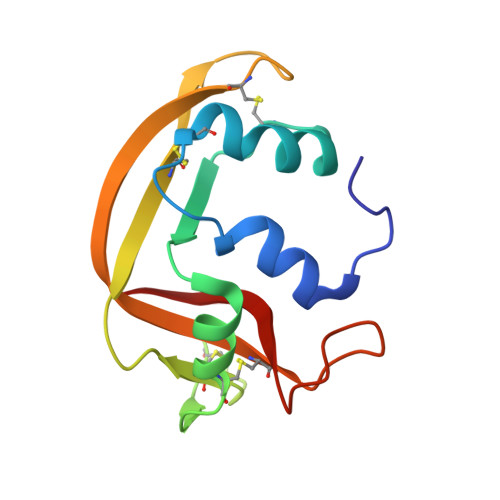Characterization of an RNase with two catalytic centers. Human RNase6 catalytic and phosphate-binding site arrangement favors the endonuclease cleavage of polymeric substrates.
Prats-Ejarque, G., Blanco, J.A., Salazar, V.A., Nogues, V.M., Moussaoui, M., Boix, E.(2019) Biochim Biophys Acta Gen Subj 1863: 105-117
- PubMed: 30287244
- DOI: https://doi.org/10.1016/j.bbagen.2018.09.021
- Primary Citation of Related Structures:
5ET4, 5OAB, 5OGH, 6ENP - PubMed Abstract:
Human RNase6 is a small cationic antimicrobial protein that belongs to the vertebrate RNaseA superfamily. All members share a common catalytic mechanism, which involves a conserved catalytic triad, constituted by two histidines and a lysine (His15/His122/Lys38 in RNase6 corresponding to His12/His119/Lys41 in RNaseA). Recently, our first crystal structure of human RNase6 identified an additional His pair (His36/His39) and suggested the presence of a secondary active site. In this work we have explored RNase6 and RNaseA subsite architecture by X-ray crystallography, site-directed mutagenesis and kinetic characterization. The analysis of two novel crystal structures of RNase6 in complex with phosphate anions at atomic resolution locates a total of nine binding sites and reveals the contribution of Lys87 to phosphate-binding at the secondary active center. Contribution of the second catalytic triad residues to the enzyme activity is confirmed by mutagenesis. RNase6 catalytic site architecture has been compared with an RNaseA engineered variant where a phosphate-binding subsite is converted into a secondary catalytic center (RNaseA-K7H/R10H). We have identified the residues that participate in RNase6 second catalytic triad (His36/His39/Lys87) and secondary phosphate-binding sites. To note, residues His39 and Lys87 are unique within higher primates. The RNaseA/RNase6 side-by-side comparison correlates the presence of a dual active site in RNase6 with a favored endonuclease-type cleavage pattern. An RNase dual catalytic and extended binding site arrangement facilitates the cleavage of polymeric substrates. This is the first report of the presence of two catalytic centers in a single monomer within the RNaseA superfamily.
Organizational Affiliation:
Department of Biochemistry and Molecular Biology, Faculty of Biosciences, Universitat Autònoma de Barcelona, E-08193 Cerdanyola del Vallès, Spain. Electronic address: [email protected].


















